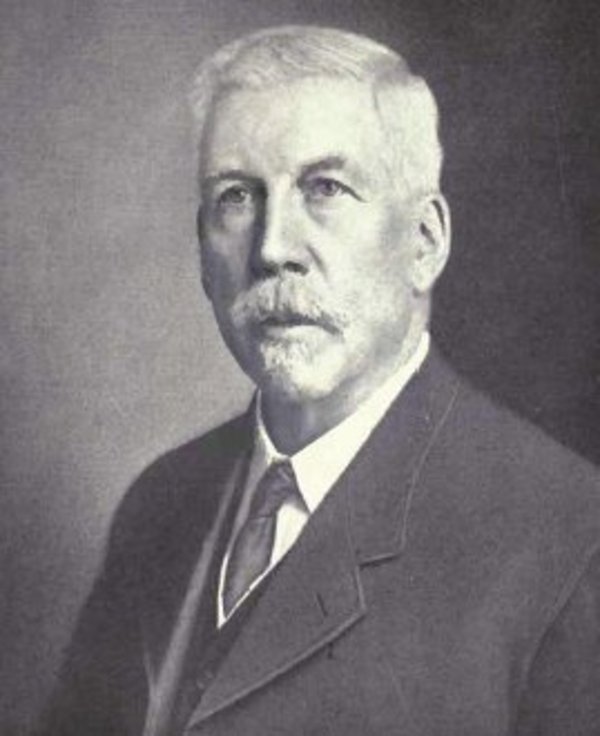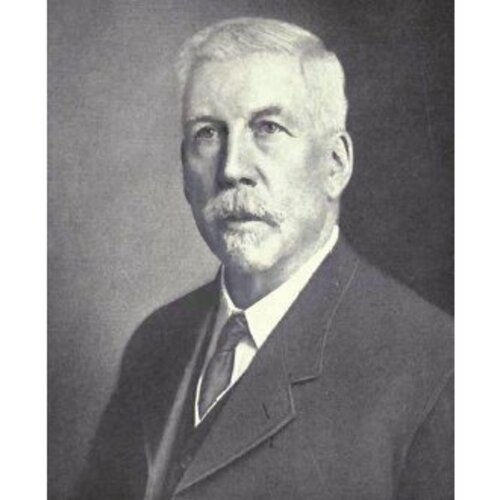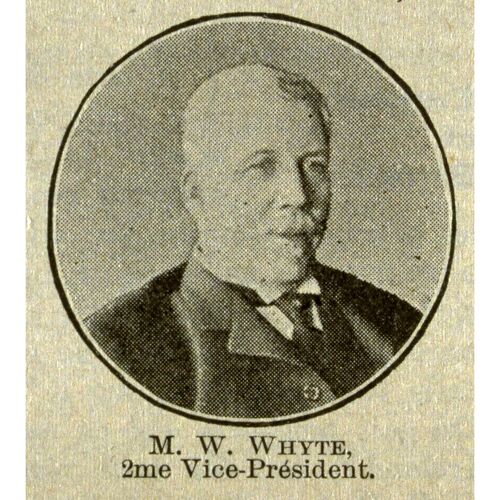
Source: Courtesy of Wikimedia Commons
WHYTE, Sir WILLIAM, railway company executive; b. 15 Sept. 1843 in Charlestown (Fife), Scotland, son of William Whyte and Christina Methven; m. 12 April 1871 Jane Scott (d. 1930) in Toronto, and they had three sons and four daughters (one son and one daughter died in infancy); d. 14 April 1914 in San Diego, Calif., and was buried in St John’s cemetery, Winnipeg.
After a short career with a Scottish railway, William Whyte emigrated to the Canadas in 1863 and accepted a job as a brakeman on the Grand Trunk Railway. Rising through the ranks, he served as freight and station agent at various locations, culminating his career with the company as the assistant superintendent of its central division. In October 1883 he moved to the Ontario and Quebec Railway as its general superintendent and a year later, when this company was leased in perpetuity to the Canadian Pacific Railway, he became the superintendent of the Ontario division. In 1886 he was transferred to Winnipeg as the superintendent of the CPR’s western division.
Whyte had begun his career with the CPR when the company was under great financial stress. Its chief purchasing agent, Thomas George Shaughnessy*, regularly berated his officials for overspending and relished belittling his western manager. The unflappable Whyte, aptly nicknamed “smooth William,” survived the abuse through capable management, balanced judgement, and undivided loyalty, eventually gaining Shaughnessy’s full trust.
To maintain the profitability of the western section, Whyte curbed expenditures, limited expansion, and defended the CPR’s monopoly. In 1888, for example, after Manitoba’s persistent, angry protests forced the federal government to repeal the CPR’s monopoly clause [see Thomas Greenway*], the railway used every possible tactic to obstruct potential rivals. Manitoba’s fiery commissioner of railways, Joseph Martin*, was equally determined. When the Northern Pacific and Manitoba Railway had to cross the CPR’s line just west of Winnipeg, Martin feared that the federal railway committee would not grant the necessary permission, so he short-circuited normal procedures and ordered a diamond-crossing installed. To counter the move, Whyte dispatched a large crew to the crossing and parked a dead locomotive across the intersection (quickly named Fort Whyte). Some scuffling and a tense stand-off followed, ended only by the onset of winter. The question was referred to the Supreme Court of Canada, which decided in favour of the Northern Pacific.
True competition required unprofitable cuts in rates and expensive construction of branch lines, however, and the Battle of Fort Whyte, as it came to be called, was only a superficial skirmish. From the western perspective, there was little improvement. As historian Ted D. Regehr has observed, high freight rates and a minimum of branch lines helped to retard the settlement of the prairies for the next decade.
At the turn of the century, a phenomenal increase in the flow of settlers forced the CPR to abandon its cautious policy. In 1901 Shaughnessy, who had succeeded Sir William Cornelius Van Horne as president of the CPR in 1899, appointed Whyte his assistant to advise him on “all matters connected with colonization, proposed extensions of the Company’s railway system, the development of industries along the Company’s lines, the establishment of new business connections and the administration of the Company’s lands, town-sites and other properties of that description.” In 1903 Whyte was elected second vice-president in charge of the western lines. He was promoted vice-president in 1910.
Whyte’s most pressing problem from 1901 was to solve the recurrent blockages hampering the export of grain from the prairies. Under his direction the company constructed nearly 4,000 miles of branch lines within a decade, multiplied its rolling stock, and experimented with ever-larger locomotives. Beginning in 1905 it commenced doubling the number of tracks from Fort William (Thunder Bay, Ont.) to Calgary, a program financed by several issues of stocks. It developed 51 new town-sites, expanded its shops in Winnipeg, enlarged sidings to accommodate bigger engines and longer trains, upgraded track, added to the chain of hotels across western Canada, and in 1910–13 constructed the High Level Bridge at Edmonton. As superintendent of the western division, Whyte was involved in all aspects of planning, financing, and executing these projects.
Whyte’s work represented a highly competent reaction to the unexpected rush of settlers onto the prairies. “Ten or twelve years ago,” he admitted, “if some one had told me that the time would come when large shipments of wheat would be made from Swift Current [Sask.], I would have said that he was a fit subject for the asylum. Yet this year we carried from that point over half a million bushels.” He met the challenge with great ability and a willingness to innovate. He was instrumental in persuading senior officials to build large-scale irrigation works in southern Alberta, for example, and to establish a number of model farms to experiment with irrigated and dry-land crops.
Easily approachable, Whyte was well regarded by the CPR’s officers and workers. An active Presbyterian and a freemason, he was particularly interested in foreign missions and local education, serving on the board of management of Manitoba College. He was created a knight bachelor in 1911. That year he retired from the CPR and took a seat on its board of directors. He also sat on the boards of several other companies.
AO, RG 80-24-0-2: 544. NA, MG 28, III 20, Shaughnessy letter-books; RG 31, C1, 1871, Stratford, Ont.: 29. Globe, 13 April 1871. Manitoba Free Press, 10, 18, 20, 22, 26 Oct. 1888; 23 Jan. 1911. Canadian annual rev. (Hopkins), 1906, 1909, 1914. Canadian Railway and Marine World (Toronto), May 1914: 216–17. David Cruise and Alison Griffiths, Lords of the line (Markham, Ont., 1988). J. A. Eagle, The Canadian Pacific Railway and the development of western Canada, 1896–1914 (Kingston, Ont., 1989); “Shaughnessy and prairie development, 1899–1914,” in The CPR west: the iron road and the making of a nation, ed. H. A. Dempsey (Vancouver and Toronto, 1984), 125–48. Encyclopaedia of Canadian biography . . . (3v., Montreal and Toronto, 1904–7), 3: 14. W. K. Lamb, History of the Canadian Pacific Railway (New York and London, 1977). Manitoba, pictorial and biographical (2v., Winnipeg, 1913). A. A. den Otter, “Adapting the environment: ranching, irrigation, and dry land farming in southern Alberta, 1880–1914,” Great Plains Quarterly (Lincoln, Nebr.), 6 (1986): 171–89. T. D. Regehr, The Canadian Northern Railway, pioneer road of the northern prairies, 1895–1918 (Toronto, 1976). Standard dict. of Canadian biog. (Roberts and Tunnell).
Cite This Article
A. A. DEN Otter, “WHYTE, Sir WILLIAM,” in Dictionary of Canadian Biography, vol. 14, University of Toronto/Université Laval, 2003–, accessed December 21, 2025, https://www.biographi.ca/en/bio/whyte_william_14E.html.
The citation above shows the format for footnotes and endnotes according to the Chicago manual of style (16th edition). Information to be used in other citation formats:
| Permalink: | https://www.biographi.ca/en/bio/whyte_william_14E.html |
| Author of Article: | A. A. DEN Otter |
| Title of Article: | WHYTE, Sir WILLIAM |
| Publication Name: | Dictionary of Canadian Biography, vol. 14 |
| Publisher: | University of Toronto/Université Laval |
| Year of publication: | 1998 |
| Year of revision: | 1998 |
| Access Date: | December 21, 2025 |




